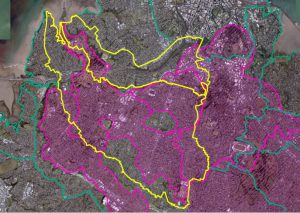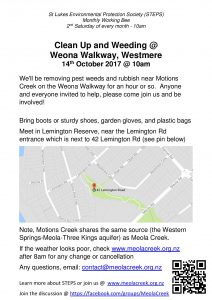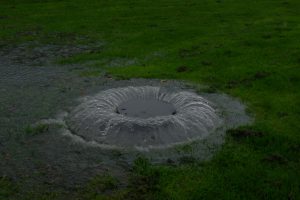Archive for October, 2017
Stormwater in the Auckland Plan
Liz October 5th, 2017
Stormwater on Auckland Isthmus
Stormwater is a heritage problem that no one wants to pass to the next generation.
- Stormwater transports sediments and heavy metals in harbours and creeks, contributing to declining wild life / water quality
- Created by hard (impervious) surfaces like roofs and roads
- Normally dealt with by local pipes, wetlands etc – Auckland has good standards in ‘green-fields’
- In parts of Auckland the stormwater infrastructure and pipes are from the 19th century
- Worst problems include Auckland roads – generate 50% of stormwater including heavy metals. Next, soakage to the aquifer on Auckland isthmus [Auckland’s largest underground water source – should be pristine… untreated stormwater is now soaking in as no stormwater pipes or treatment are in place]. Lastly Combined sewers (also on the Auckland isthmus) where stormwater shares a pipe with sewage. Existing pipes are inadequate for stormwater volumes, sending untreated sewage and stormwater into back yards; flooding creeks; destroying habitat; and polluting bays and harbours when it rains.
- Unitary plan will raise impervious surfaces on the isthmus from 42% to 62% – our harbours simply cannot cope without a major retrofit of poor / non existent stormwater infrastructure where Auckland plans “brown-fields” development
Actions needed
We want all our Councillors to vote for 21st century stormwater in the Auckland plan
– Auckland Plan refresh to contain aspirations and plans for water infrastructure (similar to those for transport]
– Long term plan to include “ring fenced” water funding for stormwater improvements on the Auckland isthmus
Invitation – if you are on Auckland Isthmus and have a concern about stormwater then please contact us and we can join you up with other groups. Your help will make a difference.
What do we propose?
Water can no longer be a buried problem
– Auckland Council has under invested in stormwater – especially relating to combined sewers and soakage.
– Clean water infrastructure must receive the same planning, funding and attention in the Auckland plan that is being given to transport.
– People living on the Auckland isthmus need similar standards to what is being built as Auckland expands into green-fields – the old stormwater infrastructure is a health risk. – There is an urgent need for local stormwater treatment systems to clean up the problems before discharge to water ways; stormwater has been found to be as damaging to streams and marine environments as coliforms are.
What is the issue?
- Auckland Council has spent money previously budgeted for stormwater upgrades on other things
- Auckland Council has a ‘debt ceiling’ – ie a limit on the money they can borrow (and spend).
- Unless we as citizens stand up for clean water in our harbours this pattern of neglect is likely to continue. See STEPS in Our Auckland
What is happening now?:
– Auckland council has high-risk beaches / locations with ongoing water quality issues, where swimming or recreational water activities are not recommended at:
• Cox’s Bay • Meola Reef • Weymouth Beach • Little Oneroa Lagoon • Wairau Outlet • Piha Lagoon • North Piha Lagoon • Wood Bay • Laingholm Beach • Te Henga (Bethells) Lagoons. (We would add • Onehunga Lagoon and inner Manukau Harbour also). Clearly pollution is not just an urban issue; our west coast beaches have been affected by failed on-site waste-water plants.
– The “Safe Swim” program later this year will alert people to this situation when the council is required to forecast and publish the quality of beach water.
– Auckland Council has a visual simulation model which shows what happens now after a sewerage overflow: the sewage sits in the water, tides go in and out and it remains… it takes a long time to ‘flush out and is dangerous to ecological and human health meanwhile.
STEPS recently joined with Manukau Harbour Restoration Society, SASOC, Friends of Oakley Creek in a stormwater presentation to the Auckland Council Environment and Community Committee (starts 29 minutes into live stream. See also our Stormwater slides and additional photos).
What is the plan?
For the isthmus, Watercare plans a central interceptor; a 13 kilometre long wastewater tunnel that will run from Western Springs to the Mangere Wastewater Treatment Plant (MWTP). It is intended to provide for future growth of Auckland, and reduce overflows to the Waitemata and Manukau Harbours from some areas. Estimated cost approximately $1 billion. [Watercare Asset Management Plan has a total $4.2 billion forecast for much more extensive wastewater infrastructure work across Auckland 2016-36. However Watercare CEO has stated that the wastewater system is only an interim solution for stormwater issues, providing some time for Auckland Council to construct adequate stormwater infrastructure for combined sewer areas.]
Additional work is required to treat stormwater, and Council is still to approve this. It may include some sewer separation and some local treatment to reduce the volumes of stormwater flowing through the sewers. Best evidence treatment for stormwater is available, has been locally piloted and implemented successfully. Treatment is different from flooding control – it can be done progressively.
Who will benefit from clean Auckland Harbours?
Yachties, swimmers, families and citizens generally would not have to deal with the sanitary items and E-coli counts that regularly show up on Auckland beaches, parks and in the water. So most Aucklanders and many other New Zealanders would gain from treating and separating stormwater.
SASOC have written more extensively on this topic.
Costs:
We believe the costs for improving stormwater infrastructure could be in the order of $1 billion. Watercare have already designed the Central Interceptor. However if Auckland Council cannot remove the large volumes of stormwater going to MWTP then future Aucklanders may have to pay Watercare Services to build an entire new waste treatment plant which could be $ billions. Stormwater treatment is an essential investment. We believe it should be included in the Auckland Plan refresh and long term plan (LTP).
Funding: Auckland politicians have mentioned a ‘targeted stormwater rate’
– The benefit of having a targeted water rate is that it can ONLY be spent on stormwater – it cannot be dissipated on lifestyle spending
Who should pay?
Weighing up costs and priorities is always a question of what we value, and our priorities. We are asking what we as NZers value about our urban environments so we propose:
- Aucklanders who enjoy beaches and water recreation
- Urban Aucklanders as the main road users (since heavy metals and oil and the largest amount of stormwater come from roads)
- Watercare waste treatment (urban) customers.
- Any Government which cares about the health of people in NZ’s largest city, about clean water, or about safe housing intensification would also consider special purpose vehicles (SPVs) like Government bonds for urban NZ to ‘catch up’ with its water infrastructure
Nation-wide water infrastructure includes: Drinking water, Waste Water and Stormwater with associated benefits to streams, harbours and ground water. Let’s remember that 86% of NZers live in cities and towns… and no one wants the next generation to be facing this unacceptable situation.
Plan for Meola & Motions Creeks and Volcanic Aquifer
Liz October 1st, 2017
Te Tatua-a-Riukiuta Aquifer and the Waititiko – Waiateao Creeks
Inspired by the commitment of the Puketapapa Local Board to Te Auanga Oakley Creek, we joined with the Weona walkway community group and approached Albert Eden Local Board regarding protection and enhancement of Meola and Motions Creeks. We proposed that the AELB annual plan include a vision for both creeks, for Council and Community groups to work towards. We have asked Puketapapa and Waitemata Boards also to contribute as key landmarks such as Te Tokaroa Meola Reef, Western Springs and Three Kings all play a major role in the Meola-Motions natural landscape.
Our catchments our the largest on the isthmus and have many different communities of interest. Both streams have poor water quality. Over centuries they have been cut up 
by public works including national roads and other infrastructure; stormwater and wastewater from whole suburbs disappears, surfacing several kilometres away in local parks like Kerr Taylor reserve. The map shows Motions and Meola catchments in yellow, and the underlying aquifer in pink.
We are entering a time of great change with a $1 billion central Interceptor and Chamberlain Park projects causing landscape changes. We feel the community needs a ‘big picture’, partly to provide a background for the community work between Watercare and Meola Forum on Meola catchment changes from Central Interceptor. We also felt it could boost recognition of the need for a (formal and informal) mountain to sea path way to connect communities for cyclists and walkers.
Here is our draft plan. Please read it and let us know what you would add or change. We welcome your input. Waititiko – Waiateao Vision
[Contributing Authors: Jeanette Budgett (Unitec Institute of Technology), Sandra Anderson (University of Auckland). With thanks for contributions from Sharon Eccleshall, Andrew Mackintosh, Nick Goldwater and others.]
We look forward to progressing this plan and vision for the community.



